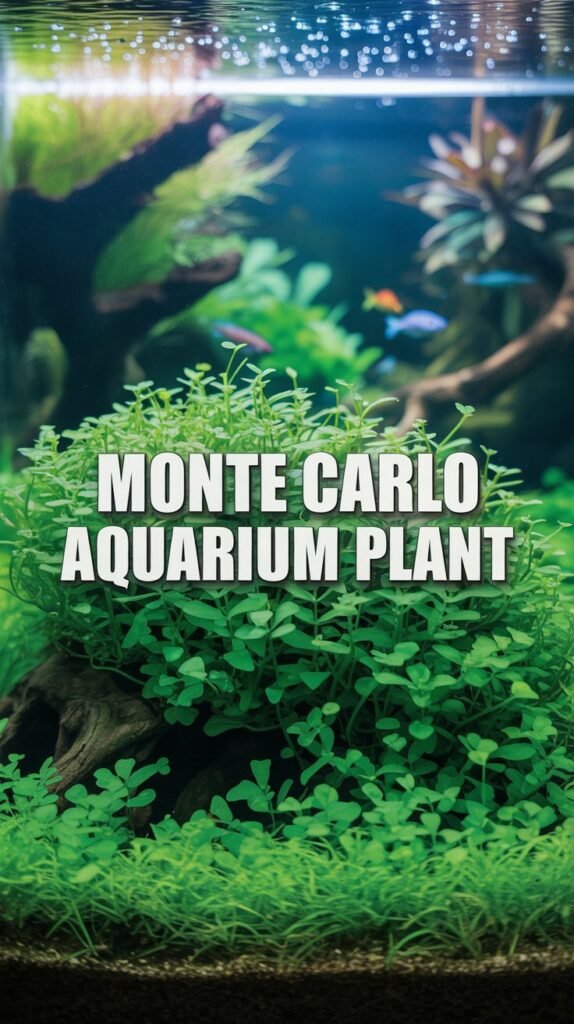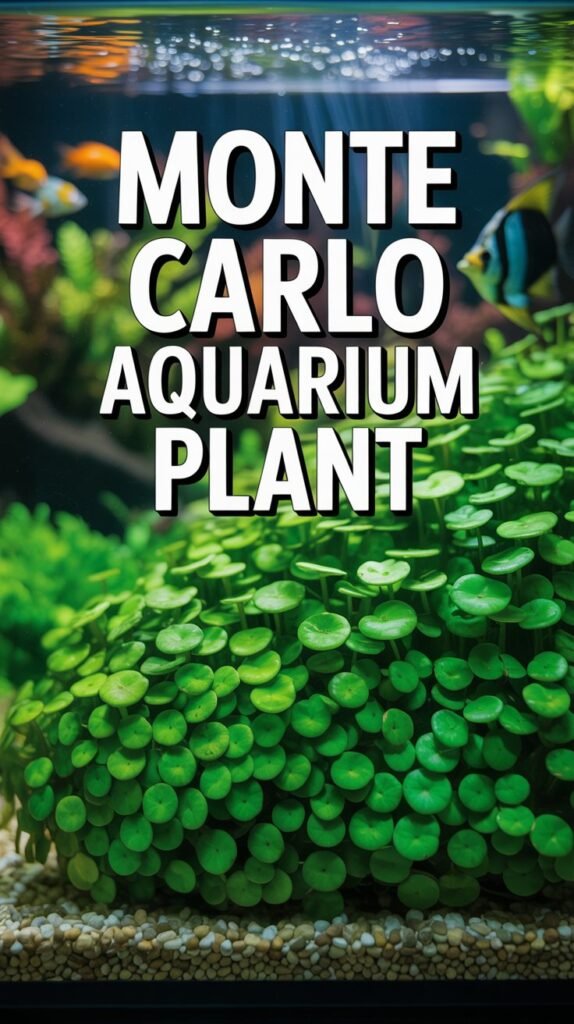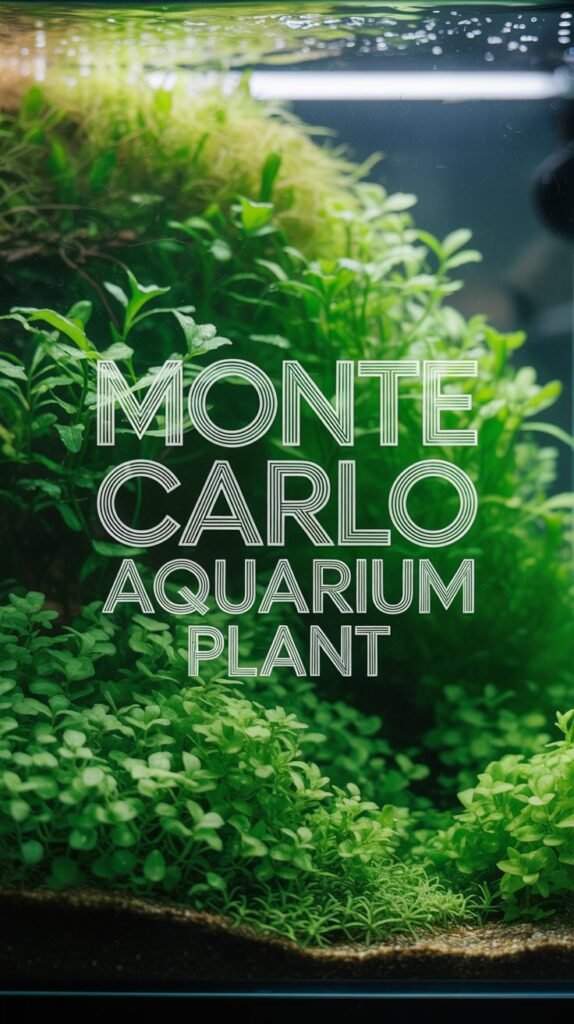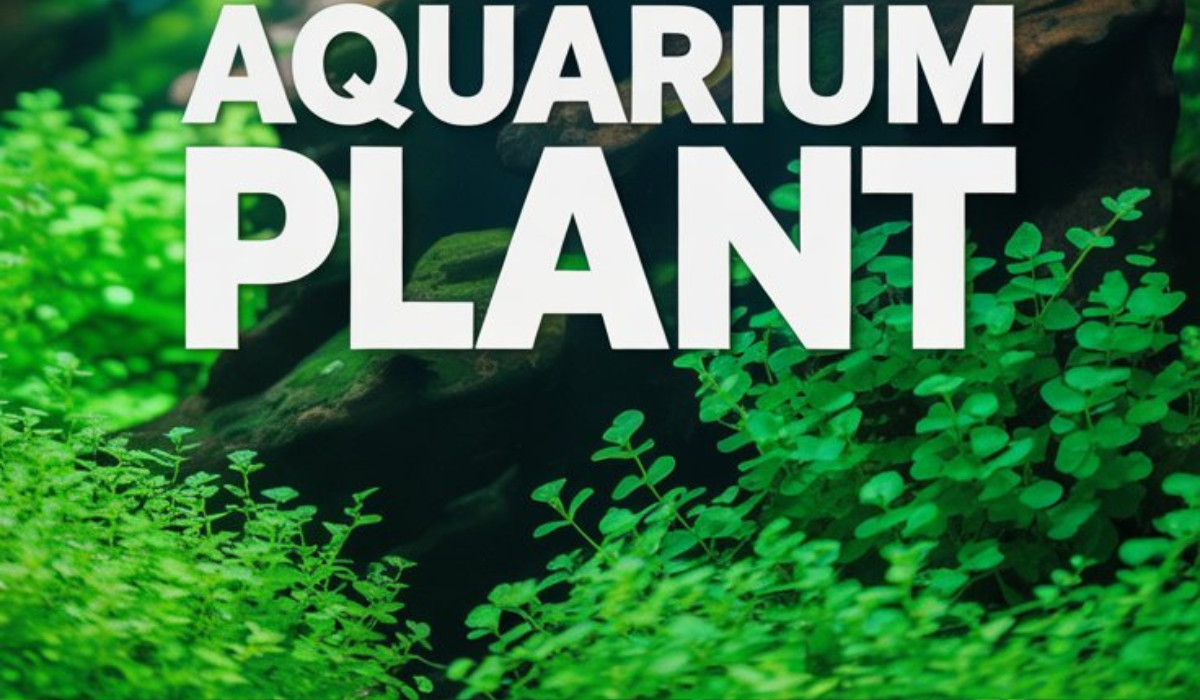The Monte Carlo aquarium plant (Micranthemum tweediei ‘Monte Carlo’) is one of the most popular and versatile carpet plants in the aquascaping world. Loved by beginners and experts alike, it adds a lush green carpet effect that transforms aquariums into natural underwater gardens. Its compact growth, vibrant color, and adaptability make it a must-have plant for planted tanks.
In this comprehensive guide, you’ll learn everything about the Monte Carlo aquarium plant — from its origin, growth conditions, and propagation methods to aquascaping tips and maintenance. Whether you’re setting up a nano tank or a professional aquascape, this guide will help you grow a healthy, beautiful Monte Carlo carpet.
1. Introduction to Monte Carlo Aquarium Plant
The Monte Carlo plant is a small, low-growing freshwater plant widely used in aquascaping. It is often chosen as a foreground or carpeting plant due to its dense mat-forming growth pattern and fresh green hue.
Monte Carlo is admired for its ability to spread quickly across the substrate, creating a natural, soft, grass-like appearance at the bottom of aquariums. Its round, light-green leaves are slightly larger than those of the popular Hemianthus callitrichoides (commonly known as Dwarf Baby Tears), but Monte Carlo is much easier to grow.
2. Origin and Natural Habitat

The Monte Carlo aquarium plant originates from Argentina, specifically from the province of Monte Carlo in Misiones, which is how it got its name. In the wild, it grows along riverbanks and moist areas, thriving in nutrient-rich substrates with moderate light.
Its natural habitat experiences fluctuating water levels, meaning the plant has adapted to both submerged and emersed (above water) conditions. This adaptability makes it one of the easiest carpeting plants for beginners to maintain in aquariums.
3. Scientific Classification
- Scientific Name: Micranthemum tweediei ‘Monte Carlo’
- Common Names: Monte Carlo, Micranthemum Monte Carlo, Tweediei Monte Carlo
- Family: Linderniaceae
- Origin: South America (Argentina)
- Growth Type: Carpet / Foreground plant
4. Appearance and Characteristics
The Monte Carlo aquarium plant features small, rounded leaves with a bright green coloration. Its leaves typically measure 0.5–1 cm in diameter and grow on creeping stems that spread horizontally along the substrate.
Key Characteristics:
- Leaf Shape: Round and compact
- Color: Bright, vibrant green
- Growth Form: Low and dense mat
- Height: 1–3 cm
- Growth Rate: Moderate to fast under good conditions
- CO₂ Requirement: Optional but enhances growth and color
Monte Carlo provides a smooth and lush foreground that enhances the depth and aesthetic of aquascapes. Its delicate leaves sway gently with water currents, creating a serene and natural look.
5. Ideal Tank Conditions for Monte Carlo
Creating the right environment is key to achieving a healthy, thriving Monte Carlo carpet. This plant adapts to a range of aquarium conditions but grows best in stable and nutrient-rich setups.
a. Tank Size
Monte Carlo is suitable for both nano tanks (5–10 gallons) and large aquariums. Its compact size makes it perfect for small setups, while its spreading ability makes it excellent for large carpet coverage.
b. Water Parameters
| Parameter | Ideal Range |
|---|---|
| Temperature | 68–78°F (20–26°C) |
| pH Level | 6.0–7.5 |
| Water Hardness | 2–12 dGH |
| Lighting | Moderate to high |
| CO₂ | Recommended but not mandatory |
Monte Carlo can grow without CO₂, but providing CO₂ injection accelerates growth, increases density, and gives the leaves a richer green color.
c. Lighting
Good lighting is crucial for Monte Carlo. Moderate to high light encourages compact and horizontal growth. Under low light, the plant may grow taller and less dense as it stretches toward the light.
LED lighting or fluorescent fixtures designed for plant growth are ideal. Aim for 8–10 hours of consistent lighting daily.
d. Substrate
Monte Carlo needs a nutrient-rich substrate to develop strong roots. The best options include:
- Aquasoil (e.g., ADA Amazonia, Fluval Stratum)
- Fine-grain sand with root tabs
- Plant-based substrates
Avoid coarse gravel because it makes it difficult for the plant to root and spread properly.
6. Planting Monte Carlo in Your Aquarium

Proper planting ensures successful establishment and even carpet coverage.
Step-by-Step Guide:
- Preparation: Rinse the plant to remove debris or pests. If using tissue culture cups, gently wash off the gel under clean water.
- Divide into Portions: Split the plant into small clumps (each about 2–3 cm wide).
- Planting: Use aquarium tweezers to insert the clumps into the substrate, spaced about 1 inch apart.
- Submerge and Settle: Fill the aquarium slowly to avoid dislodging the plants.
- Initial Maintenance: For the first week, maintain stable lighting and CO₂ to help the roots anchor.
Within a few weeks, the plant will start spreading, connecting the clumps, and forming a dense carpet.
7. Growth and Propagation
Monte Carlo spreads horizontally through creeping stems that develop new roots and leaves along their nodes. Once established, it grows quickly and covers the substrate evenly.
Propagation Method:
- Trim a section of the carpet.
- Replant the cuttings into another area of the substrate.
- Within a few days, the new plants will root and begin spreading.
Regular trimming encourages thicker, more compact growth and prevents the bottom layers from suffocating due to lack of light.
8. Monte Carlo Aquarium Plant Maintenance
Monte Carlo is relatively low-maintenance compared to other carpeting plants, but consistent care ensures optimal results.
Routine Maintenance Tips:
- Trim regularly to maintain height (1–2 cm) and promote density.
- Siphon debris gently during water changes to prevent detritus buildup.
- Fertilize using liquid and root fertilizers for steady nutrient supply.
- Monitor light and CO₂ to prevent algae growth.
Frequent trimming not only keeps the carpet neat but also stimulates new lateral shoots, resulting in a lush and healthy mat.
9. Fertilization and Nutrient Requirements
Monte Carlo benefits from a balanced supply of macronutrients (NPK) and micronutrients. Nutrient deficiency can lead to yellowing leaves or slow growth.
a. Root Fertilizers
- Use root tabs for nutrient enrichment in the substrate.
- Replace every 2–3 months for continuous nourishment.
b. Liquid Fertilizers
- Apply comprehensive plant fertilizers weekly.
- Ensure nutrients like iron, potassium, and magnesium are present.
c. CO₂ Supplementation
- While Monte Carlo can grow without CO₂, it thrives better with injection.
- CO₂ levels of 20–30 ppm encourage faster carpet formation and richer color.
10. Common Problems and Solutions
a. Yellowing or Melting Leaves
Cause: Nutrient deficiency or sudden change in water parameters.
Solution: Maintain stable conditions, add fertilizers, and trim damaged areas.
b. Algae Growth
Cause: Excess light, high nutrients, or poor CO₂ balance.
Solution: Adjust light duration, improve water flow, and introduce algae eaters like Amano shrimp.
c. Lifting Carpet
Cause: Poor initial rooting or water flow lifting new shoots.
Solution: Replant lifted sections deeply and reduce surface agitation.
d. Slow Growth
Cause: Low light or absence of CO₂.
Solution: Increase lighting intensity and add CO₂ or root tabs.
11. Monte Carlo vs Dwarf Baby Tears
| Feature | Monte Carlo | Dwarf Baby Tears |
|---|---|---|
| Leaf Size | Slightly larger | Very small |
| Growth Rate | Faster | Slower |
| Difficulty | Easy to moderate | Difficult |
| CO₂ Requirement | Optional | Essential |
| Adaptability | High | Low |
Monte Carlo is an ideal alternative for aquarists who love the look of Dwarf Baby Tears but want easier maintenance.
12. Aquascaping with Monte Carlo

Monte Carlo is widely used in nature aquariums and Iwagumi-style aquascapes due to its aesthetic and functional benefits.
a. Foreground Carpet
It forms a soft, green carpet that complements rocks, driftwood, and midground plants.
b. Hill and Slope Designs
Monte Carlo can grow on slopes and rocks, adding natural realism to scapes. Use glue or mesh to anchor it initially.
c. Transition Zones
It works beautifully between foreground and midground plants like Staurogyne repens or Cryptocoryne parva.
d. Nano Tanks
Its compact size and controlled growth make it ideal for small aquariums.
Tip: Combine Monte Carlo with hardscape elements like Seiryu stones or driftwood for a professional, natural look.
13. Suitable Tank Mates
Monte Carlo coexists well with peaceful fish and invertebrates. However, avoid plant-eating species that may uproot or damage it.
Recommended Tank Mates:
- Guppies
- Neon Tetras
- Cherry Shrimp
- Amano Shrimp
- Otocinclus Catfish
- Corydoras
- Rasboras
Shrimp and small catfish even help clean debris from the plant’s surface, promoting better health.
14. Emersed Growth
Monte Carlo can also grow emersed (above water) in terrariums, paludariums, and wetland setups. When grown emersed, the leaves become slightly thicker, and the plant produces tiny white flowers.
Transitioning from emersed to submerged form may cause temporary melting, but new underwater leaves soon appear.
15. Advantages of Monte Carlo Aquarium Plant
- Beginner-Friendly: Easier to grow than other carpet plants.
- Versatile: Suitable for all tank sizes and aquascape styles.
- Adaptable: Thrives with or without CO₂.
- Fast Growth: Covers the substrate within weeks.
- Aesthetic Appeal: Creates a lush green lawn effect.
- Improves Water Quality: Absorbs excess nutrients, reducing algae.
- Provides Shelter: Offers hiding spots for fry and shrimp.
16. Trimming and Replanting Techniques
Regular trimming keeps Monte Carlo compact and vibrant. Use sharp aquascaping scissors to cut the top layer horizontally.
Trimming Tips:
- Trim once every 2–3 weeks.
- Don’t remove too much at once — 1/3 of the carpet is ideal.
- Replant trimmed portions to fill bare areas.
Consistent trimming prevents lower leaves from decaying due to lack of light and maintains a clean, dense carpet.
17. Lighting and Photoperiod Tips
Monte Carlo thrives under 8–10 hours of moderate to high light daily. Excessive light may cause algae, while insufficient light leads to sparse growth.
Use timers to maintain a consistent photoperiod. Combining lighting with CO₂ and fertilization creates the ideal growth triangle for dense carpeting.
18. How to Grow Monte Carlo Without CO₂
Growing Monte Carlo without CO₂ is possible if the following conditions are met:
- Use nutrient-rich substrate.
- Maintain moderate lighting.
- Perform regular water changes (30% weekly).
- Use liquid fertilizers consistently.
- Avoid overcrowding the tank.
While growth will be slower, the plant will still form an attractive carpet with proper care.
19. Monte Carlo in Low-Tech Tanks
Monte Carlo is one of the few carpet plants that can adapt to low-tech aquariums. It can grow steadily under:
- Medium lighting
- No CO₂ injection
- Occasional fertilization
In low-tech setups, trimming may be less frequent, but patience is required as the plant spreads slower.
20. Conclusion
The Monte Carlo aquarium plant is a cornerstone of modern aquascaping. Its lush, green carpet and simple maintenance make it an excellent choice for aquarists at any level. Whether you want to build a natural underwater meadow, enhance your hardscape design, or simply add greenery to your tank, Monte Carlo delivers beauty, balance, and vitality.
Its adaptability, resilience, and aesthetic value make it one of the most rewarding plants to grow in freshwater aquariums. With proper care — good lighting, stable water conditions, and occasional trimming — Monte Carlo will transform your aquarium into a thriving underwater landscape.
FAQs About Monte Carlo Aquarium Plant
1. Is the Monte Carlo plant easy to grow?
Yes. It’s one of the easiest carpeting plants to grow, making it ideal for beginners.
2. Does Monte Carlo require CO₂?
No, but adding CO₂ speeds up growth and improves leaf density and color.
3. How long does it take for Monte Carlo to carpet?
Under optimal conditions, it forms a full carpet in 4–8 weeks.
4. Can Monte Carlo grow without substrate?
It can be attached to rocks or mesh temporarily, but it grows best in nutrient-rich substrate.
5. How often should I trim Monte Carlo?
Trim every 2–3 weeks to maintain compact growth and prevent shading of lower layers.
6. Can I grow Monte Carlo in a nano tank?
Absolutely! Its small leaves and dense carpet make it perfect for nano aquariums.
7. What’s the ideal lighting for Monte Carlo?
Moderate to high light (8–10 hours daily) ensures compact and healthy growth.
8. Why is my Monte Carlo turning yellow?
Yellowing usually indicates nutrient deficiency or lack of CO₂. Add fertilizers or improve light intensity.
9. Is Monte Carlo safe for shrimp?
Yes, shrimp love grazing on it and often use it as a shelter.
10. Can Monte Carlo grow emersed?
Yes, it can grow above water in terrariums and will produce small white flowers.

